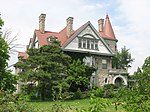Cincinnati Zoo and Botanical Garden

The Cincinnati Zoo & Botanical Garden is the second oldest zoo in the United States, founded in 1873 and officially opening in 1875, after the Roger Williams Park Zoo (1872). It is located in the Avondale neighborhood of Cincinnati, Ohio. It originally began with 64.5 acres (26.1 ha) in the middle of the city, but has spread into the neighboring blocks and several reserves in Cincinnati's outer suburbs. It was appointed as a National Historic Landmark in 1987.The zoo houses over 500 animals and 3,000 plant species. In addition, the zoo also has conducted several breeding programs in its history, and was the first to successfully breed California sea lions. In 1986, the Lindner Center for Conservation and Research of Endangered Wildlife (CREW) was created to further the zoo's goal of conservation. The zoo is known for being the home of Martha, the last living passenger pigeon, and to Incas, the last living Carolina parakeet.The zoo is an accredited member of the Association of Zoos and Aquariums (AZA), and a member of the World Association of Zoos and Aquariums (WAZA).A 2014 ranking of the nations's best zoos by USA Today based on data provided by the Association of Zoos and Aquariums lists the Cincinnati Zoo among the best in the country. A 2019 reader's choice ranking of the nation's best zoos by USA Today named the Cincinnati Zoo the top zoo in North America.
Excerpt from the Wikipedia article Cincinnati Zoo and Botanical Garden (License: CC BY-SA 3.0, Authors, Images).Cincinnati Zoo and Botanical Garden
Vine Street, Cincinnati Avondale
Geographical coordinates (GPS) Address External links Nearby Places Show on map
Geographical coordinates (GPS)
| Latitude | Longitude |
|---|---|
| N 39.145 ° | E -84.508 ° |
Address
Cincinnati Zoo and Botanical Garden
Vine Street
45268 Cincinnati, Avondale
Ohio, United States
Open on Google Maps








